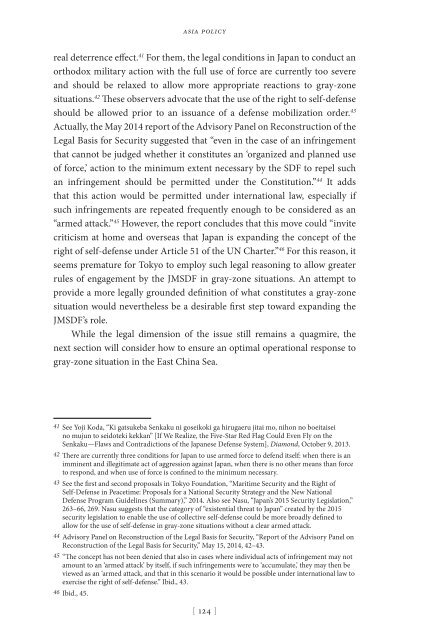2jBVKVf
2jBVKVf
2jBVKVf
Create successful ePaper yourself
Turn your PDF publications into a flip-book with our unique Google optimized e-Paper software.
asia policy<br />
real deterrence effect. 41 For them, the legal conditions in Japan to conduct an<br />
orthodox military action with the full use of force are currently too severe<br />
and should be relaxed to allow more appropriate reactions to gray-zone<br />
situations. 42 These observers advocate that the use of the right to self-defense<br />
should be allowed prior to an issuance of a defense mobilization order. 43<br />
Actually, the May 2014 report of the Advisory Panel on Reconstruction of the<br />
Legal Basis for Security suggested that “even in the case of an infringement<br />
that cannot be judged whether it constitutes an ‘organized and planned use<br />
of force,’ action to the minimum extent necessary by the SDF to repel such<br />
an infringement should be permitted under the Constitution.” 44 It adds<br />
that this action would be permitted under international law, especially if<br />
such infringements are repeated frequently enough to be considered as an<br />
“armed attack.” 45 However, the report concludes that this move could “invite<br />
criticism at home and overseas that Japan is expanding the concept of the<br />
right of self-defense under Article 51 of the UN Charter.” 46 For this reason, it<br />
seems premature for Tokyo to employ such legal reasoning to allow greater<br />
rules of engagement by the JMSDF in gray-zone situations. An attempt to<br />
provide a more legally grounded definition of what constitutes a gray-zone<br />
situation would nevertheless be a desirable first step toward expanding the<br />
JMSDF’s role.<br />
While the legal dimension of the issue still remains a quagmire, the<br />
next section will consider how to ensure an optimal operational response to<br />
gray-zone situation in the East China Sea.<br />
41 See Yoji Koda, “Ki gatsukeba Senkaku ni goseikoki ga hirugaeru jitai mo, nihon no boeitaisei<br />
no mujun to seidoteki kekkan” [If We Realize, the Five-Star Red Flag Could Even Fly on the<br />
Senkaku—Flaws and Contradictions of the Japanese Defense System], Diamond, October 9, 2013.<br />
42 There are currently three conditions for Japan to use armed force to defend itself: when there is an<br />
imminent and illegitimate act of aggression against Japan, when there is no other means than force<br />
to respond, and when use of force is confined to the minimum necessary.<br />
43 See the first and second proposals in Tokyo Foundation, “Maritime Security and the Right of<br />
Self-Defense in Peacetime: Proposals for a National Security Strategy and the New National<br />
Defense Program Guidelines (Summary),” 2014. Also see Nasu, “Japan’s 2015 Security Legislation,”<br />
263–66, 269. Nasu suggests that the category of “existential threat to Japan” created by the 2015<br />
security legislation to enable the use of collective self-defense could be more broadly defined to<br />
allow for the use of self-defense in gray-zone situations without a clear armed attack.<br />
44 Advisory Panel on Reconstruction of the Legal Basis for Security, “Report of the Advisory Panel on<br />
Reconstruction of the Legal Basis for Security,” May 15, 2014, 42–43.<br />
45 “The concept has not been denied that also in cases where individual acts of infringement may not<br />
amount to an ‘armed attack’ by itself, if such infringements were to ‘accumulate,’ they may then be<br />
viewed as an ‘armed attack, and that in this scenario it would be possible under international law to<br />
exercise the right of self-defense.” Ibid., 43.<br />
46 Ibid., 45.<br />
[ 124 ]


